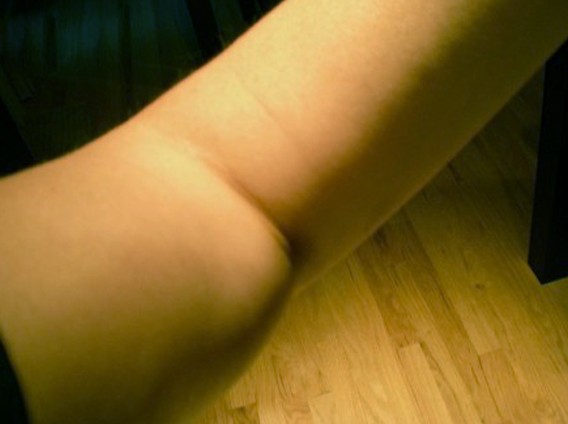Rhabdomyolysis
Definition
Rhabdomyolysis is a medical condition, in which the skeletal muscle tissue that was damaged starts to break down in a fast manner. The breakdown process leads to the release of products, from the damaged muscle tissue into the bloodstream. Among the products that are released, there are proteins, such as myoglobin. These proteins can have a harmful effect for the kidneys, leading to renal insufficiency, among other problems.
As you will have the opportunity to read below, the severity of the symptoms depends on the extensiveness of the muscle damage and also on the appearance of renal insufficiency. Among the most common symptoms of rhabdomyolysis, you will find: mental confusion, vomiting and intense pain at the level of the affected muscles. There are numerous physical factors that can contribute to the appearance of the muscle damage, including: crushing injuries, infection, medication, substance abuse and intense physical exercise. Inherited conditions that affect the muscles can also increase the risk for rhabdomyolysis. The diagnosis of this condition is made with the help of blood tests and analysis of urine samples. The treatment approaches vary, ranging from the administration of intravenous fluids to dialysis or hemofiltration.
Rhabdomyolysis Symptoms
These are the most common symptoms that lead to the appearance of rhabdomyolysis:
- Pain at the level of the affected muscles
- Tenderness upon touching the affected area
- Weakness
- Inflammation of the muscles
- Systemic symptoms can also be present (especially in those who have suffered from acute injuries, with fluid being delivered to the damaged muscles from the bloodstream) – low blood pressure, vascular collapse, shock
- The release of products from the breakdown process can lead to an imbalance in the level of electrolytes, which can lead to the following symptoms:
- Nausea and vomiting
- Mental confusion
- Coma
- Abnormal heart rhythm
- Changes in the color of the urine (dark urine) – indicate the presence of proteins that have resulted from the breakdown process (such as myoglobin)
- In case of kidney damage or renal insufficiency, the urine output might be reduced or even absent (depends on the extent of the damage, usually appears between 12-24 hours after the muscle damage)
- Compartment syndrome – the person might experience a loss of sensation in the respective limb or part of the body
- Disseminated intravascular coagulation – this is a complication of the rhabdomyolysis, leading to excessive bleeding.
What are the Causes of Rhabdomyolysis?
These are the most common causes that lead to the appearance of rhabdomyolysis:
- Intense physical exercise (especially if the person does not drink sufficient quantities of water)
- Alcohol withdrawal (this condition is also known as delirium tremens)
- Tetanus
- Epilepsy (especially in the situation of prolonged or frequent epileptic seizures)
- Crush syndrome (acute trauma)
- Blast injury (frequent in situations of explosions)
- Vehicle accidents
- Physical abuse (or even torture)
- Being bedridden (such as it happens with patients who have suffered from a cerebrovascular stroke, those who have undergone different types of surgical intervention etc.)
- Arterial thrombosis
- Embolism
- Artery clamping (during surgical intervention)
- Metabolic changes
- Hyperglycemia
- Elevated/reduced sodium levels
- Reduced potassium levels
- Low calcium levels
- Hypothyroidism
- Changes in the body temperature
- Medication
- Statins and fibrates
- Antipsychotic medication
- Anesthetics
- SSRIs
- Diuretics
- Poisoning
- Heavy metals
- Venom (insects/snakes)
- Substance abuse/alcohol intoxication
- Alcohol
- Amphetamine
- Cocaine
- Heroin
- LSD
- Ecstasy
- Infectious microorganisms
- Coxsackie virus
- Influenza virus
- Epstein-Barr virus
- Autoimmune disorders
- Polymyositis
- Dermatomyositis
Diagnosis
These are the most common methods used for the diagnosis of rhabdomyolysis:
- Level of creatine kinase in the blood (enzyme released by damaged muscle)
- Level of lactate dehydrogenase (LDH)
- Identification of other markers of muscle damage (in chronic conditions affecting the muscles) – aldolase, carbonic anhydrase type 3 , troponin and fatty acid binding protein
- Liver markers – increased levels of liver enzymes (transaminases)
- Blood testing for potassium levels (commonly high)
- Electrocardiography – identify whether the high potassium levels are affecting the health of the heart
- Urine analysis – changes in color and texture of the urine.
Treatment
These are the most common treatment approaches considered for rhabdomyolysis:
- Administration of intravenous fluids – treatment of the vascular collapse and preservation of the kidney function (isotonic saline)
- Administration of calcium – protection against cardiac complications
- Insulin/salbutamol – compensate for electrolyte imbalances
- Renal replacement therapy – in case of kidney dysfunction
- Hemodialysis
- Continuous hemofiltration
- Peritoneal dialysis
- Surgical intervention – recommended in case of complications, such as:
- Compartment syndrome – fasciotomy
- Debridement and skin grafting might also be necessary
- Supportive measures in case of disseminated intravascular coagulation (administration of platelets)
Prevention
These are the best methods to ensure the prevention of rhabdomyolysis:
- Checking the medication you are taking for such side-effects (often a problem with medication intended to lower the high cholesterol levels; talk to your doctor about switching to other medication, without such side-effects)
- Planning your exercise routine in a careful manner, so as to avoid the negative consequences of intense physical exercise
- It is recommended that you avoid performing physical exercise in a hot environment and you drink adequate amounts of water (you can also drink water with electrolytes, so as to compensate for the electrolyte imbalance)
- Do not perform intense physical exercise all of a sudden. Take things gradually and increase the amount of effort on a daily basis. In this way, you will allow for the muscles to build endurance and also to develop cardiovascular resistance to physical effort.
- Eat a healthy diet, especially one that is rich in carbohydrates (necessary for the proper functioning of the muscles)
- Avoid dehydration, as it can have negative effects on the muscles and also on the kidneys
- During physical exercise, wear clothes that are loose, as they allow for a better ventilation effect.
In conclusion, rhabdomyolysis is a medical condition that can affect both people who have suffered from acute injuries but also professional athletes who perform intense physical exercise. The treatment approach depends on the severity of the condition and also on the presence of life-threatening symptoms, as it happens with those who have been victims of earthquakes or other natural disasters. The main objective of the treatment in this case is to stabilize the patient, preventing the vascular shock and keeping the kidneys functioning.
Rhabdomyolysis Pictures

